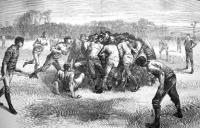Caid
Published in 18th-19th Century Social Perspectives, 18th–19th - Century History, Features, Issue 4 (July/August 2011), Volume 19
Not caid but rugby—both games involved scrimmages of men attempting to gain possession, before passing to the fleeter-footed players hovering on the wings, who ran with the ball in hand. (Illustrated London News, 25 November 1871)
The traditional game of caid was popular with the Kerry peasantry throughout the nineteenth century. The game used a ball made of farm animal skins with an inflated bladder within, giving it an oval shape. It was played in the winter months, usually between teams from two neighbouring parishes, the ball being thrown up among them at an agreed central point. Matches were played cross-country over fields and hedges, and tripping, pushing and wrestling were accepted methods of impeding the progress of opponents. The winning team was the one that managed to bring the ball ‘home’ to its own parish.
















